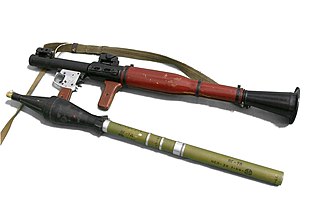
A rocket-propelled grenade (RPG) is a shoulder-fired rocket weapon that launches rockets equipped with an explosive warhead. Most RPGs can be carried by an individual soldier, and are frequently used as anti-tank weapons. These warheads are affixed to a rocket motor which propels the RPG towards the target and they are stabilized in flight with fins. Some types of RPG are reloadable with new rocket-propelled grenades, while others are single-use. RPGs are generally loaded from the front.
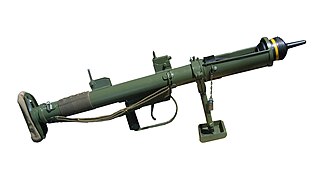
The Projector, Infantry, Anti Tank (PIAT) Mk I was a British man-portable anti-tank weapon developed during the Second World War. The PIAT was designed in 1942 in response to the British Army's need for a more effective infantry anti-tank weapon and entered service in 1943.

The Bazooka is a man-portable recoilless anti-tank rocket launcher weapon, widely deployed by the United States Army, especially during World War II. Also referred to as the "stovepipe", the innovative Bazooka was among the first generation of rocket-propelled anti-tank weapons used in infantry combat. Featuring a solid-propellant rocket for propulsion, it allowed for high-explosive anti-tank (HEAT) shaped charge warheads to be delivered against armored vehicles, machine gun nests, and fortified bunkers at ranges beyond that of a standard thrown grenade or mine. The universally applied nickname arose from the weapon's M1 variant's vague resemblance to the musical instrument called a bazooka invented and popularized by 1930s American comedian Bob Burns.

High-explosive anti-tank (HEAT) is the effect of a shaped charge explosive that uses the Munroe effect to penetrate heavy armor. The warhead functions by having an explosive charge collapse a metal liner inside the warhead into a high-velocity shaped charge jet; this is capable of penetrating armor steel to a depth of seven or more times the diameter of the charge. The shaped charge jet armor penetration effect is purely kinetic in nature; the round has no explosive or incendiary effect on the armor.

The Panzerfaust was a development family of single-shot man-portable anti-tank systems developed by Nazi Germany during World War II. The weapons were the first single-use light anti-tank weapons based on a pre-loaded disposable launch tube, a weapon configuration which is still used today.

Panzerschreck was the popular name for the Raketenpanzerbüchse 54, an 88 mm reusable anti-tank rocket launcher developed by Nazi Germany in World War II. Another earlier, official name was Ofenrohr.
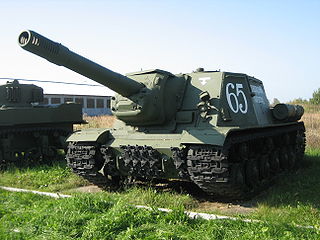
The ISU-152 is a Soviet self-propelled gun developed and used during World War II. It was unofficially nicknamed Zveroboy in response to several large German tanks and guns coming into service, including Tigers and Panthers. Since the ISU-152's gun was mounted in a casemate, aiming it was awkward, and had to be done by repositioning the entire vehicle using the tracks. Therefore, it was used as mobile artillery to support more mobile infantry and armor attacks. It continued service into the 1970s and was used in several campaigns and countries.

Shoulder-fired missile, shoulder-launched missile or man-portable missile, among other variants, are common slang terms to describe high-caliber shoulder-mounted weapons systems; that is, weapons firing large, heavy projectiles ("missiles"), typically using the backblast principle, which are small enough to be carried by a single person and fired while held on one's shoulder. The word "missile" in this context is used in its original broad sense of a heavy projectile, and encompasses all shells and rockets, guided or unguided. A more formal variant is simply shoulder-fired weapons system and the like.

The RPG-7 is a portable, reusable, unguided, shoulder-launched, anti-tank, rocket launcher. The RPG-7 and its predecessor, the RPG-2, were designed by the Soviet Union, and are now manufactured by the Russian company Bazalt. The weapon has the GRAU index 6G3.

The M72 LAW is a portable one-shot 66 mm (2.6 in) unguided anti-tank weapon.

The RPG-26 Aglen is a disposable anti-tank rocket-propelled grenade (RPG) launcher developed by the Soviet Union. It fires a one-stage rocket with jack-knife fins, which unfold after launch. The rocket carries a 72.5-millimetre (2.85 in) diameter high-explosive anti-tank (HEAT) single shaped charge warhead able to penetrate 440 millimetres (17 in) of armour, 1 metre of reinforced concrete or 1.5 metres of brickwork. It has a maximum effective range of around 250 metres (820 ft). The similar sized rocket features a slightly heavier and more powerful HEAT warhead and more powerful rocket engine. The limited extension of the RPG-22 launch tube was found of little use. Thus, the RPG-26 has a rigid non-telescoping launch tube.
The RPG-27 is a Soviet single shot disposable rocket-propelled grenade (RPG) shoulder-fired missile and rocket launcher. It entered service with the Soviet Army in 1989.

The M67 recoilless rifle is a 90 mm anti-tank recoilless rifle made in the United States and later in South Korea. It could also be employed in an anti-personnel role with the use of the M590 antipersonnel round. It was designed to be fired primarily from the ground using the bipod and monopod, but could also be fired from the shoulder using the folded bipod as a shoulder rest and the monopod as a front grip. The weapon was air-cooled and breech-loaded, and fired fixed ammunition. It is a direct fire weapon employing stadia lines to allow simple range finding, based on a typical tank target bridging the lines once in range.
The Panzerfaust 3 is a modern semi-disposable recoilless anti-tank weapon, which was developed between 1978 and 1985 and first entered service with the Bundeswehr in 1987. It was first ordered in 1973 to provide West German infantry with an effective weapon against contemporary Soviet armor, thereby replacing West Germany's aging PzF 44 Light Lanze launchers and the heavy Carl Gustaf 84 mm anti-tank recoilless rifle manufactured in Sweden.
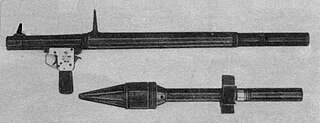
The RPG-2 is a man-portable, shoulder-fired anti-tank weapon that was designed in the Soviet Union. It was the first successful anti-tank weapon of its type, being a successor to the earlier and unsuccessful rocket-propelled grenade RPG-1.

55 S 55, colloquially kevyt sinko and nicknamed Nyrkki, was a Finnish recoilless anti-tank weapon from the mid-1950s. The 55 S 55 was designed by a Finnish Defence Forces team led by MSc, Capt Esko Puronto, and it was manufactured by FDF's Vammaskoski factory.
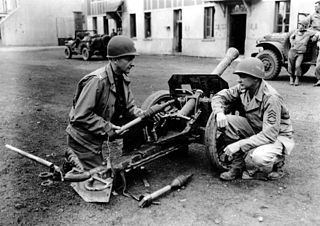
The 8.8 cm Raketenwerfer 43 Puppchen was an 88 mm calibre reusable anti-tank rocket launcher developed by Nazi Germany during World War II.

The PzF 44, was a West German portable recoilless shoulder-fired anti-tank rocket launcher with a barrel-caliber of 44 mm (1.7 in). It was the spiritual successor to the Panzerfaust from World War II and served with the West German Army from the early 1960s to the early 1990s, when it was replaced by the Panzerfaust 3 semi-disposable launcher.

The RL-83 Blindicide is mainly an anti-tank warfare rocket launcher, but other types of rounds can be fired. It was produced by Mecar SA of Belgium and was an improved derivative of the M20A1 bazooka. Its name roughly means "tank killer", derived from the French "véhicule blindé" and the suffix -cide.

Man-portable anti-tank systems are traditionally portable shoulder-launched projectile systems firing heavy shell-type projectiles, typically designed to combat protected targets, such as armoured vehicles, field fortifications and at times even low-flying aircraft.

















